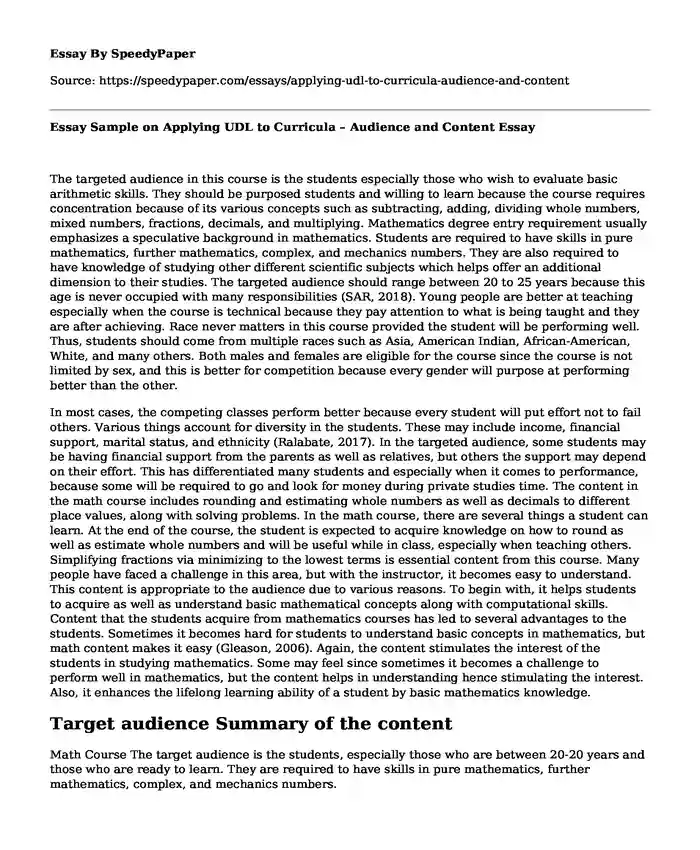
| Type of paper: | Essay |
| Categories: | Learning Students Mathematics Diversity |
| Pages: | 3 |
| Wordcount: | 705 words |
The targeted audience in this course is the students especially those who wish to evaluate basic arithmetic skills. They should be purposed students and willing to learn because the course requires concentration because of its various concepts such as subtracting, adding, dividing whole numbers, mixed numbers, fractions, decimals, and multiplying. Mathematics degree entry requirement usually emphasizes a speculative background in mathematics. Students are required to have skills in pure mathematics, further mathematics, complex, and mechanics numbers. They are also required to have knowledge of studying other different scientific subjects which helps offer an additional dimension to their studies. The targeted audience should range between 20 to 25 years because this age is never occupied with many responsibilities (SAR, 2018). Young people are better at teaching especially when the course is technical because they pay attention to what is being taught and they are after achieving. Race never matters in this course provided the student will be performing well. Thus, students should come from multiple races such as Asia, American Indian, African-American, White, and many others. Both males and females are eligible for the course since the course is not limited by sex, and this is better for competition because every gender will purpose at performing better than the other.
In most cases, the competing classes perform better because every student will put effort not to fail others. Various things account for diversity in the students. These may include income, financial support, marital status, and ethnicity (Ralabate, 2017). In the targeted audience, some students may be having financial support from the parents as well as relatives, but others the support may depend on their effort. This has differentiated many students and especially when it comes to performance, because some will be required to go and look for money during private studies time. The content in the math course includes rounding and estimating whole numbers as well as decimals to different place values, along with solving problems. In the math course, there are several things a student can learn. At the end of the course, the student is expected to acquire knowledge on how to round as well as estimate whole numbers and will be useful while in class, especially when teaching others. Simplifying fractions via minimizing to the lowest terms is essential content from this course. Many people have faced a challenge in this area, but with the instructor, it becomes easy to understand. This content is appropriate to the audience due to various reasons. To begin with, it helps students to acquire as well as understand basic mathematical concepts along with computational skills. Content that the students acquire from mathematics courses has led to several advantages to the students. Sometimes it becomes hard for students to understand basic concepts in mathematics, but math content makes it easy (Gleason, 2006). Again, the content stimulates the interest of the students in studying mathematics. Some may feel since sometimes it becomes a challenge to perform well in mathematics, but the content helps in understanding hence stimulating the interest. Also, it enhances the lifelong learning ability of a student by basic mathematics knowledge.
Target audience Summary of the content
Math Course The target audience is the students, especially those who are between 20-20 years and those who are ready to learn. They are required to have skills in pure mathematics, further mathematics, complex, and mechanics numbers.
The content includes rounding and estimating whole numbers as well as decimals to different place values, along with solving problems. Simplifying fractions via minimizing to the lowest terms is essential content from this course. It stimulates the interest of the students in studying mathematics.
References
Gleason, J. (2006, May 27). Teaching Mathematics Online: A Virtual Classroom - Preparing for the Course | Mathematical Association of America. Retrieved 9 July 2020, from https://www.maa.org/press/periodicals/loci/joma/teaching-mathematics-online-a-virtual-classroom-preparing-for-the-course
Ralabate, P. (2017, December 11). Universal Design for Learning: Meeting the Needs of All Students. Retrieved July 07, 2020, from https://www.readingrockets.org/article/universal-design-learning-meeting-needs-all-students
SAR, H. (2018, December 14). The Mathematics Curriculum in Primary and Lower Secondary Grades – TIMSS 2015 Encyclopedia. Retrieved 9 July 2020, from http://timssandpirls.bc.edu/timss2015/encyclopedia/countries/hong-kong-sar/the-mathematics-curriculum-in-primary-and-lower-secondary-grades/#:~:text=The%20curriculum%20covers%20five%20content,%3B%20Data%20Handling%3B%20and%20Algebra.&text=Algebra%20is%20introduced%20in%20Grade,area%20at%20the%20primary%20level.
Cite this page
Essay Sample on Applying UDL to Curricula - Audience and Content. (2023, Sep 28). Retrieved from https://speedypaper.net/essays/applying-udl-to-curricula-audience-and-content
Request Removal
If you are the original author of this essay and no longer wish to have it published on the SpeedyPaper website, please click below to request its removal:
- Biology Essay Example: Structure of Eukaryotic Cells
- The Mississippi Freedom Summer Project - Essay Sample for Students
- Deportation Law of the United States in the Free Essay
- Essay Sample: Analogue Studies of Life on Mars
- Free Essay: Technology Selection Study Recommendation Paper
- Paper Example. Diversity in a Workplace
- Paper Example. Online Learning is Less Satisfactory than Face-To-Face
Popular categories




